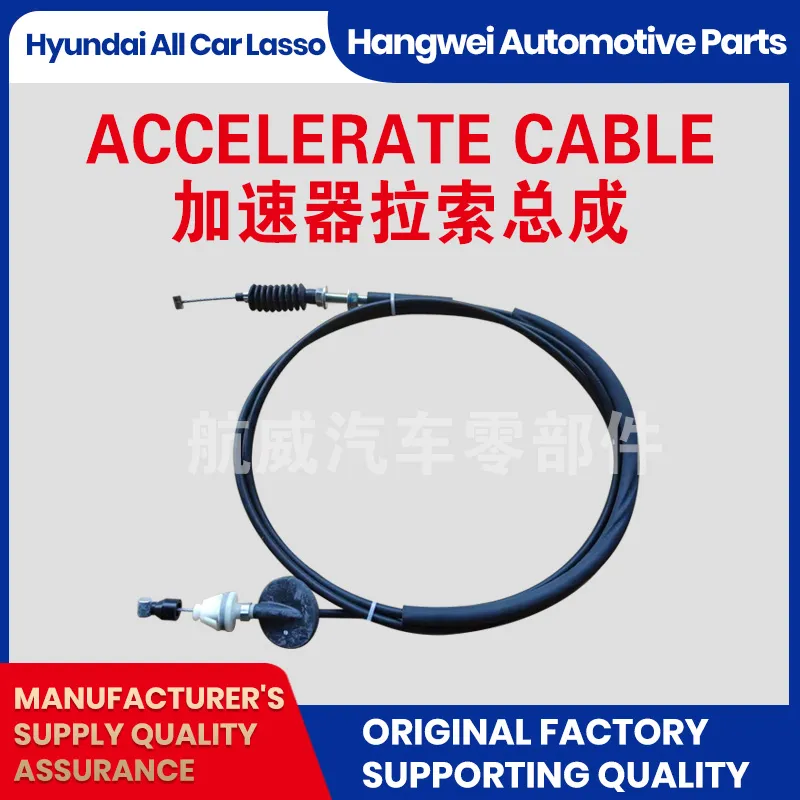Throttle Cable – Durable, Smooth, Universal Fit & Adjustable
Accelerator Push-Pull Cable: the quiet hero behind smooth acceleration
In an era obsessed with sensors and silicon, the humble Throttle Cable still decides how crisply a pedal translates into forward motion. I’ve toured small-batch shops and big-tier suppliers, and—honestly—the craft that goes into a good mechanical control cable still surprises people. The Accelerator Push-Pull Cable here is designed to transmit pedal input with minimal friction and zero drama, which is exactly how drivers like it.
What’s changing in the market (and what isn’t)
Drive-by-wire is everywhere, yet fleets, powersports, generators, and commercial vehicles keep specifying a Throttle Cable for durability, cost control, and predictable feel. Real-world feedback from mechanics suggests hybrid setups—mechanical actuation with electronic oversight—are sticking around, especially in heavy-duty and off-road equipment. To be honest, when mud, salt, and vibration enter the chat, mechanical still wins on serviceability.

Field photo: production-ready Accelerator Push-Pull assembly with low-friction liner.
Core specifications (typical)
| Inner wire | Stainless steel 304/316 stranded, ≈1.5–2.5 mm |
| Conduit | Galvanized steel spiral with HDPE or PTFE liner |
| Stroke length | Up to ≈150 mm (custom up to ≈250 mm) |
| Operating temp | -40°C to +120°C (PTFE liner to +150°C) |
| Pull force rating | Up to ≈300 N static; real-world use may vary |
| Compliance | Built to DIN 71986, inner wire per ISO 2408 guidance |
| Service life | ≥300,000 cycles at 80°C, 12 N load (lab-tested) |
How it’s made (quick process map)
- Materials: SS304/316 stranded inner wire; galvanized or stainless conduit; HDPE/PTFE low-friction liner; zinc die-cast or swaged end fittings.
- Methods: precision stranding → conduit winding → liner extrusion → end-fitting swaging/die-casting → assembly → preload/length set.
- Testing: friction and pull testing; salt spray per ASTM B117; dimensional checks; cycle/endurance rigs; optional ISO 9227 equivalents on request.
- Target life: around 300k–500k cycles depending on routing and load.
- Industries: automotive, motorcycle/ATV/UTV, ag equipment, marine throttle linkages, gensets, material handling.
Customization that actually matters
End fittings (barrel, clevis, ball stud), stroke and overall length, liner material, seals/boots, firewall grommets, adjusters, brackets, and packaging. Many customers say a small tweak to the liner or routing radius solved 80% of their pedal-feel complaints. It seems that PTFE liners are worth it in dusty or high-temp duty.
Vendor comparison (field-notes summary)
| Criteria | HWEI Accelerator Push-Pull | OEM Brand A | Budget Importer B |
|---|---|---|---|
| Cycle life (tested) | ≈300k–500k | ≈400k–600k | ≈100k–200k |
| Friction feel | Low; consistent | Very low | Inconsistent |
| Lead time | 2–4 weeks typical | 4–8 weeks | 1–2 weeks |
| Certifications | ISO 9001, IATF 16949 | IATF 16949 | Varies; often none |
Applications and real-world wins
- Off-road UTV builder: switched to PTFE-lined Throttle Cable; warranty claims dropped by ≈38% over 12 months (dust ingress issue solved).
- City bus fleet: re-routed cable with tighter bend spec; pedal effort variance cut from 20% to 6% across vehicles, according to the maintenance lead.
Internal test data snapshot: after 96 hours neutral salt spray (ASTM B117), assemblies showed no red rust on stainless components and maintained functional pull within ±5% tolerance. Not perfect science, but it’s a solid indicator.
Why spec this assembly
Advantages include low-stick slip, predictable return, robust corrosion resistance, and serviceable ends. Manufactured in Qinghe County Minjiang Street south, Wuzhishan Road east, with traceability for audits—helpful if you’re dealing with IATF-tier customers.
Certifications and standards
Quality system: ISO 9001 and IATF 16949. Mechanical design references: DIN 71986 (control cables), inner wire aligned with ISO 2408 principles. Corrosion testing via ASTM B117 (or ISO 9227 on request).
References:
- DIN 71986 – Control cables (Bowden) for road vehicles. Beuth Verlag: https://www.beuth.de
- ASTM B117 – Standard Practice for Operating Salt Spray (Fog) Apparatus. ASTM International: https://www.astm.org/b117-19.html
- ISO 2408 – Steel wire ropes — Requirements. ISO: https://www.iso.org/standard/67402.html
- IATF 16949 – Automotive Quality Management System. IATF: https://www.iatfglobaloversight.org
-
Clutch Line: Braided, Leak-Proof, OEM-Grade PerformanceNewsNov.10,2025
-
Throttle Cable: Durable, Smooth Control & Universal FitNewsNov.10,2025
-
Throttle Cable: Durable, Smooth, Universal Fit, Easy InstallNewsNov.10,2025
-
Clutch Line: Durable, Leak-Proof, OEM-Grade PerformanceNewsNov.10,2025
-
Hand Brake Cable | Custom, Universal & Trailer SolutionsNewsNov.10,2025
-
Clutch Line: High-Pressure, OEM-Fit, Corrosion-ResistantNewsNov.03,2025
